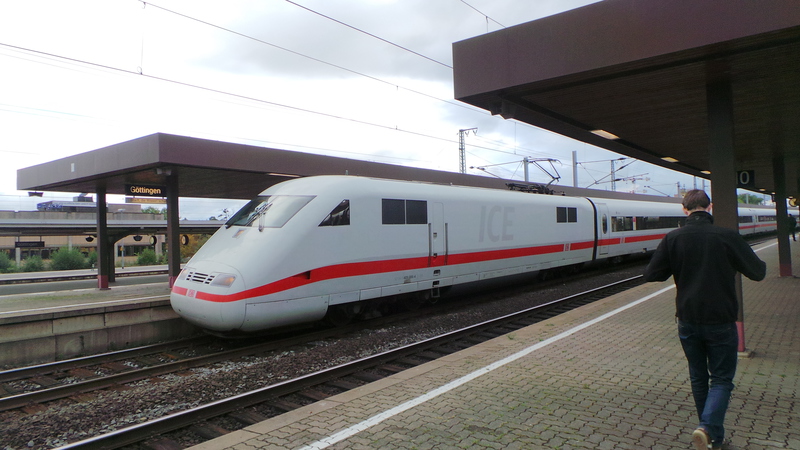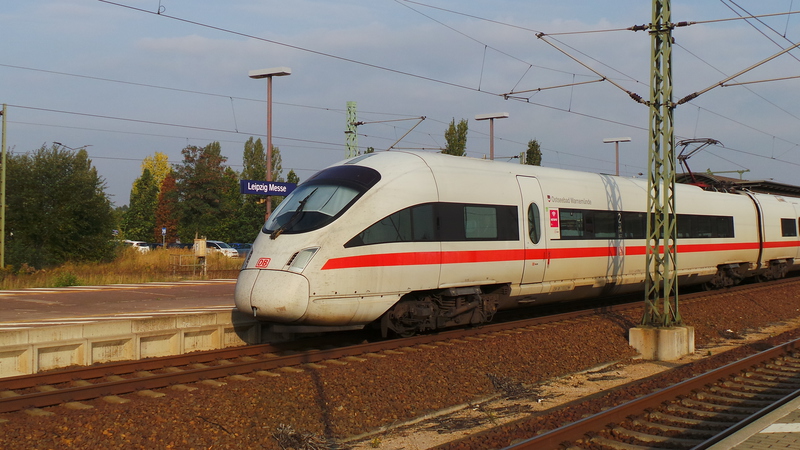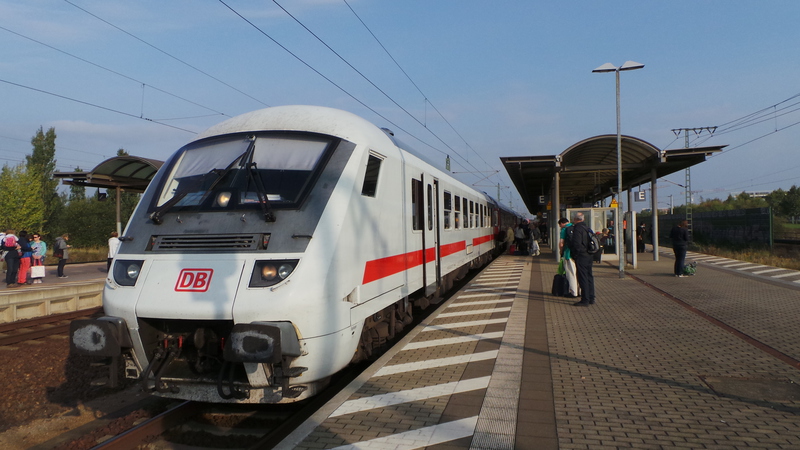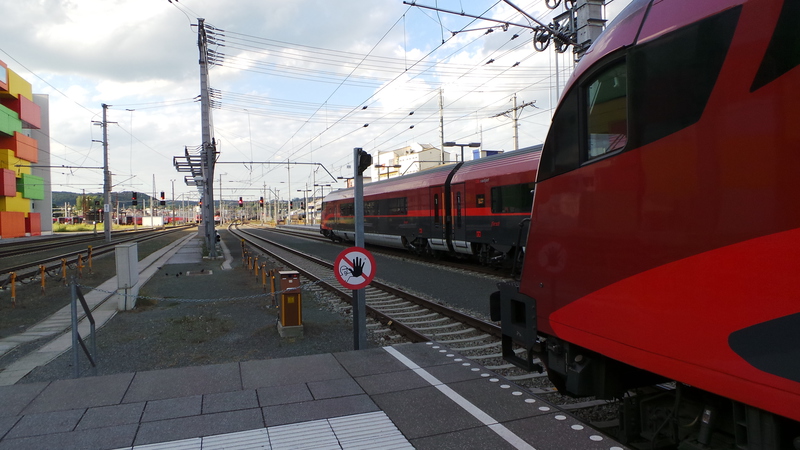by ALR997
Hello
today my plan is to give you a little information about future developements from some railway networks in Europe. I try to avoid speculation but as you will see in Germany, you can't look into future without some conjecture.
I planned to tell you something about some other states, too, but I realized, that it takes more time, than I thought, so now it's just Germany - just because it's for me the most easy thing to explain.
Edit: I've added a few pictures of some trains to show, what I'm talking about. Maybe it's easier then to understand, what I mean
1. Germany
New routes:
The last new high-speed route was opened in december 2015 between Leipzig and Erfurt. Hourly trains from Dresden and Leipzig to Frankfurt as well as the few new Sprinter trains between Berlin and Frankfurt use this route. Although it's constructed for a 300 km/h (186 mph)-speed, the only trains riding there are the ICE-T-trains (max. 230 km/h/143 mph). Main reason is that these were the only trains which are compatible to the installed European Train Control System (ETCS).
During construction work on the classic main line between Nuremberg and Leipzig a two-hourly service (Hamburg - Munich) also was changed to this route with a 140-km-detour. From coming december all trains on this relation will use this high-speed line (HSL).
Because on 10 december the new HSL from Erfurt to Ebensfeld (on existing tracks further to Nuremberg) will open for commercial services. The new service pattern will include (all services each two hours):
-Hamburg - Berlin - Frankfurt - Munich (only between Leipzig and Erfurt) - with ICE 1
-Dresden - Frankfurt - Wiesbaden (only between Leipzig and Erfurt) - with ICE-T
-Berlin - Frankfurt (Sprinter, only between Leipzig and Erfurt) - I'm not really sure, but I think it will run with ICE-T
-Berlin - Munich (Sprinter) - with ICE 3 (only train which really can reach 300 km/h), runs only four times a day
-Berlin - Halle - Munich - with ICE-T, later with ICE 4
-Berlin - Leipzig - Munich - with ICE 1 (when they can ride on ETCS), later with ICE 4
The main target with the Berlin-Munich-Sprinter is to reach a travel time under 4 hours - which is two hours faster than the trains today are.
Another HSL under construction will connect tuttgart and Ulm combined with a new underground main railway station in Stuttgart (Stuttgart 21). The HSL will open in 2021 (you can bet it'll get later ^^) and reduce the travel time to Ulm from 50 to 30 minutes. This route is part of the planned European main line (TEN project 17) from Paris to Vienna. While you have a LGV between Paris and Strasbourg (330 km/h), a new line between Salzburg and Vienna (250 km/h) and higher-speed lines between Augsburg and Munich as well as between Strasbourg and Stuttgart (up to 250 km/h, with slower tracks between) the parts from Stuttgart to Ulm and Munich to Salzburg belong to the slowest sections on this line. The fastest connection from Paris to Vienna today takes about 10 hours (changing in Stuttgart and Salzburg), with the finished and planned improvements you can go under eight hours, maybe less.
South of Frankfurt there is a planned line to Mannheim to close the gap on the HSL from Cologne to Stuttgart (later to Munich). The first proposals startet in the early 90s but in the 00s and 10s it came to stop. Today there are dicussions about a station in Darmstadt and the type of integration of Mannheim - latters fear that the trains wouldn't stop there if a high-speed line would bypass the city. From my view you can assume that the opening won't take place before 2030, although it is necessary to introduce new trains especially to Stuttgart but also to Munich.
Same region, other route: the triangle Frankfurt-Fulda-Würzburg is an important part of the german railway system. Both for freight and passenger transport. Frankfurt - Fulda is used by 3 ICE per hour and direction (Hamburg/Berlin - Stuttgart/Munich/Switzerland), Frankfurt - Würzburg by 1-2 (Rhine-Ruhr/Hamburg - Nuremberg/Munich/Vienna) and Fulda - Würzburg by 1 (Hamburg - Munich). But only Fulda - Würzburg is a HSL, while both other lines are winding through the Central Uplands (Spessart, Rhön, e.g.) with adequate travel times and a lot of conflicts with freight and regional trains. Here honestly no one knows what exactly will be built because there are a lot of options and lot more problems, for example with local residents.
New trains:
Today the DB has more than 350 long-distance trains which are sperated in 58 ICE 1, 44 ICE 2, 80 ICE 3, 67 ICE-T, 82 classic IC, 27 IC2 and a few ICE 4.
The ICE 1 are operating since 1991 and were modernized in 2005. If you take a lifespan of 30 years, which is usual, the service will end in 2021. But until then the trains will get a second refreshment and a new use. Last thing I've heard was that the trains will be shortened (I think 8 or 9 instead of 12 cars today) and used in IC services. But in this case I am not absolutely sure.
The ICE 2 - which you can see as a short version of ICE 1 (not exactly but close enough) on the other hand will be extended from 7 to 10 cars by reducing the total number of trains. In service since 1996 and redesigned in 2011 the trains will operate until approximately 2025, when new ICE 4 will take over.

The ICE1 has two power cars, one at each end. The shorter ICE2 has a cab car on the other end. By prolonging the ICE2 the cab car would vanish and the power car from each second ICE2 would be connected instead.
The fastest ICE-trains (ICE 3) operate since 2000 and later (last ICE 3-Velaro started only a few years ago) and now the first few trains finished their redesign. Until now they only operated on the corridor from Rhine-Ruhr to the South (Munich, Stuttgart, Switzerland), on international high-speed services and occasionally on some other routes. Now from december the HSL between Berlin and Munic also will see some ICE 3. For the nearer future the service is safe, but my big question is, what may happen from 2030, when first ICE 3 will close down. Either DB orders new 300-km/h-trains respectively someone else does this or the ICE 4, which only runs up to 250 km/h, takes these services, too.
The ICE 4 is the newest train here: 12 cars, since last fall DB provides a probation service on a few ICE-routes. The first line with ICE 4 will be Hamburg - München according to some unofficial information in december. Followed by Hamburg - Stuttgart next year and Berlin - Munich in 2019.
In december 2020 the first IC line should get ICE 4 between Hamburg, Cologne and Stuttgart. A shorter version with only 7 coaches will run between Cologne and Berlin coupled between Hamm and Berlin as a double train, just like today with the ICE 2-trains. DB has ordered 100 long ICE 4 and 19 short until now.

Here's a picture of the new ICE4.
ICE-T is in service since 1999 and is something like a long-term surrogate. It's a tilting train which was designed for higher-speed IC-services but just before starting the operation it was changed into ICE. So now the trains are needed between Leipzig and Erfurt because of the train operating system, but with upgrading ICE1, 3 and 4 for ETCS some of the ICE-T will run between Hamburg, Cologne and Vienna (requiring a travel time of about 14 hours). There are also some plans to run direct ICE-services from Vienna to Hamburg or Berlin via Nuremberg, which is at least two hours faster than going via Prague and Dresden.

The ICE-T.
Most ICE-TD were set out of service last december because of pending examination. Only a few trains are in service whose deadline hasn't been reached yet. But there are no future plans for these trains - I think all of them will get scrapped.
Classic IC coaches are running on eight two-hourly lines and a few other services, in addition there are many foreign operators (EuroCity to Italy, Switzerland, Austria, Czechia and Poland) and two private operators in Germany with compareble stock(HKX and Locomore). Most of these coaches are quite modern with plugs and air conditioning, but DB anyhow plans to replace their coaches by new ones, so these havn't got a very bright future.

The IC-coaches were modernized a few years ago to survive their last years in service. From the inside (maybe a picture follows) they look similar to ICE now.
The newest IC generation are the double-decker IC2, running from Cologne and the North Sea to Leipzig and Dresden. In 2016 and in future too they're also running from Cologne directly to the North Sea, and next december there are also services planned from Stuttgart to Karlsruhe, Zürich and Nuremberg. According to the latest plans of DB there are a lot of new IC-lines connecting the more rural areas where ICs and IRs vanished in the past. In 2019 two new lines will connect Rostock and Dresden and Münster and Frankfurt, and a lot more routes until 2032. The IC2 has no stationary food providing and runs only 160 km/h (100 mph).

The double-decker IC is similar to regional trains regarding the material. Alone the interior is different.
A few months ago DB announced to order new IC-coaches compareble to Railjet in Austria to replace the old IC-coaches, to get for example on non-electricified routes to the North Sea or the Alps, and also to serve IC-lines which are too important for the IC2. These trains are now called ICneu (new IC) but I also heared the name IC3. The first of these trains may operate from the early 2020s.

The Austrian Railjet could be a possible template for the new IC train. It has a locomotive and coaches, but these coaches are fixed and tight so you havn't got a problem with the air pressure on board.
That's all for now. I'll follow with some views to other countries later but I think, it's enough for today.
I hope you can understand my writing and you are on a current status now about long-distance rail in Germany
Best regards,
Lucas
today my plan is to give you a little information about future developements from some railway networks in Europe. I try to avoid speculation but as you will see in Germany, you can't look into future without some conjecture.
I planned to tell you something about some other states, too, but I realized, that it takes more time, than I thought, so now it's just Germany - just because it's for me the most easy thing to explain.
Edit: I've added a few pictures of some trains to show, what I'm talking about. Maybe it's easier then to understand, what I mean
1. Germany
New routes:
The last new high-speed route was opened in december 2015 between Leipzig and Erfurt. Hourly trains from Dresden and Leipzig to Frankfurt as well as the few new Sprinter trains between Berlin and Frankfurt use this route. Although it's constructed for a 300 km/h (186 mph)-speed, the only trains riding there are the ICE-T-trains (max. 230 km/h/143 mph). Main reason is that these were the only trains which are compatible to the installed European Train Control System (ETCS).
During construction work on the classic main line between Nuremberg and Leipzig a two-hourly service (Hamburg - Munich) also was changed to this route with a 140-km-detour. From coming december all trains on this relation will use this high-speed line (HSL).
Because on 10 december the new HSL from Erfurt to Ebensfeld (on existing tracks further to Nuremberg) will open for commercial services. The new service pattern will include (all services each two hours):
-Hamburg - Berlin - Frankfurt - Munich (only between Leipzig and Erfurt) - with ICE 1
-Dresden - Frankfurt - Wiesbaden (only between Leipzig and Erfurt) - with ICE-T
-Berlin - Frankfurt (Sprinter, only between Leipzig and Erfurt) - I'm not really sure, but I think it will run with ICE-T
-Berlin - Munich (Sprinter) - with ICE 3 (only train which really can reach 300 km/h), runs only four times a day
-Berlin - Halle - Munich - with ICE-T, later with ICE 4
-Berlin - Leipzig - Munich - with ICE 1 (when they can ride on ETCS), later with ICE 4
The main target with the Berlin-Munich-Sprinter is to reach a travel time under 4 hours - which is two hours faster than the trains today are.
Another HSL under construction will connect tuttgart and Ulm combined with a new underground main railway station in Stuttgart (Stuttgart 21). The HSL will open in 2021 (you can bet it'll get later ^^) and reduce the travel time to Ulm from 50 to 30 minutes. This route is part of the planned European main line (TEN project 17) from Paris to Vienna. While you have a LGV between Paris and Strasbourg (330 km/h), a new line between Salzburg and Vienna (250 km/h) and higher-speed lines between Augsburg and Munich as well as between Strasbourg and Stuttgart (up to 250 km/h, with slower tracks between) the parts from Stuttgart to Ulm and Munich to Salzburg belong to the slowest sections on this line. The fastest connection from Paris to Vienna today takes about 10 hours (changing in Stuttgart and Salzburg), with the finished and planned improvements you can go under eight hours, maybe less.
South of Frankfurt there is a planned line to Mannheim to close the gap on the HSL from Cologne to Stuttgart (later to Munich). The first proposals startet in the early 90s but in the 00s and 10s it came to stop. Today there are dicussions about a station in Darmstadt and the type of integration of Mannheim - latters fear that the trains wouldn't stop there if a high-speed line would bypass the city. From my view you can assume that the opening won't take place before 2030, although it is necessary to introduce new trains especially to Stuttgart but also to Munich.
Same region, other route: the triangle Frankfurt-Fulda-Würzburg is an important part of the german railway system. Both for freight and passenger transport. Frankfurt - Fulda is used by 3 ICE per hour and direction (Hamburg/Berlin - Stuttgart/Munich/Switzerland), Frankfurt - Würzburg by 1-2 (Rhine-Ruhr/Hamburg - Nuremberg/Munich/Vienna) and Fulda - Würzburg by 1 (Hamburg - Munich). But only Fulda - Würzburg is a HSL, while both other lines are winding through the Central Uplands (Spessart, Rhön, e.g.) with adequate travel times and a lot of conflicts with freight and regional trains. Here honestly no one knows what exactly will be built because there are a lot of options and lot more problems, for example with local residents.
New trains:
Today the DB has more than 350 long-distance trains which are sperated in 58 ICE 1, 44 ICE 2, 80 ICE 3, 67 ICE-T, 82 classic IC, 27 IC2 and a few ICE 4.
The ICE 1 are operating since 1991 and were modernized in 2005. If you take a lifespan of 30 years, which is usual, the service will end in 2021. But until then the trains will get a second refreshment and a new use. Last thing I've heard was that the trains will be shortened (I think 8 or 9 instead of 12 cars today) and used in IC services. But in this case I am not absolutely sure.
The ICE 2 - which you can see as a short version of ICE 1 (not exactly but close enough) on the other hand will be extended from 7 to 10 cars by reducing the total number of trains. In service since 1996 and redesigned in 2011 the trains will operate until approximately 2025, when new ICE 4 will take over.

The ICE1 has two power cars, one at each end. The shorter ICE2 has a cab car on the other end. By prolonging the ICE2 the cab car would vanish and the power car from each second ICE2 would be connected instead.
The fastest ICE-trains (ICE 3) operate since 2000 and later (last ICE 3-Velaro started only a few years ago) and now the first few trains finished their redesign. Until now they only operated on the corridor from Rhine-Ruhr to the South (Munich, Stuttgart, Switzerland), on international high-speed services and occasionally on some other routes. Now from december the HSL between Berlin and Munic also will see some ICE 3. For the nearer future the service is safe, but my big question is, what may happen from 2030, when first ICE 3 will close down. Either DB orders new 300-km/h-trains respectively someone else does this or the ICE 4, which only runs up to 250 km/h, takes these services, too.
The ICE 4 is the newest train here: 12 cars, since last fall DB provides a probation service on a few ICE-routes. The first line with ICE 4 will be Hamburg - München according to some unofficial information in december. Followed by Hamburg - Stuttgart next year and Berlin - Munich in 2019.
In december 2020 the first IC line should get ICE 4 between Hamburg, Cologne and Stuttgart. A shorter version with only 7 coaches will run between Cologne and Berlin coupled between Hamm and Berlin as a double train, just like today with the ICE 2-trains. DB has ordered 100 long ICE 4 and 19 short until now.

Here's a picture of the new ICE4.
ICE-T is in service since 1999 and is something like a long-term surrogate. It's a tilting train which was designed for higher-speed IC-services but just before starting the operation it was changed into ICE. So now the trains are needed between Leipzig and Erfurt because of the train operating system, but with upgrading ICE1, 3 and 4 for ETCS some of the ICE-T will run between Hamburg, Cologne and Vienna (requiring a travel time of about 14 hours). There are also some plans to run direct ICE-services from Vienna to Hamburg or Berlin via Nuremberg, which is at least two hours faster than going via Prague and Dresden.

The ICE-T.
Most ICE-TD were set out of service last december because of pending examination. Only a few trains are in service whose deadline hasn't been reached yet. But there are no future plans for these trains - I think all of them will get scrapped.
Classic IC coaches are running on eight two-hourly lines and a few other services, in addition there are many foreign operators (EuroCity to Italy, Switzerland, Austria, Czechia and Poland) and two private operators in Germany with compareble stock(HKX and Locomore). Most of these coaches are quite modern with plugs and air conditioning, but DB anyhow plans to replace their coaches by new ones, so these havn't got a very bright future.

The IC-coaches were modernized a few years ago to survive their last years in service. From the inside (maybe a picture follows) they look similar to ICE now.
The newest IC generation are the double-decker IC2, running from Cologne and the North Sea to Leipzig and Dresden. In 2016 and in future too they're also running from Cologne directly to the North Sea, and next december there are also services planned from Stuttgart to Karlsruhe, Zürich and Nuremberg. According to the latest plans of DB there are a lot of new IC-lines connecting the more rural areas where ICs and IRs vanished in the past. In 2019 two new lines will connect Rostock and Dresden and Münster and Frankfurt, and a lot more routes until 2032. The IC2 has no stationary food providing and runs only 160 km/h (100 mph).

The double-decker IC is similar to regional trains regarding the material. Alone the interior is different.
A few months ago DB announced to order new IC-coaches compareble to Railjet in Austria to replace the old IC-coaches, to get for example on non-electricified routes to the North Sea or the Alps, and also to serve IC-lines which are too important for the IC2. These trains are now called ICneu (new IC) but I also heared the name IC3. The first of these trains may operate from the early 2020s.

The Austrian Railjet could be a possible template for the new IC train. It has a locomotive and coaches, but these coaches are fixed and tight so you havn't got a problem with the air pressure on board.
That's all for now. I'll follow with some views to other countries later but I think, it's enough for today.
I hope you can understand my writing and you are on a current status now about long-distance rail in Germany
Best regards,
Lucas